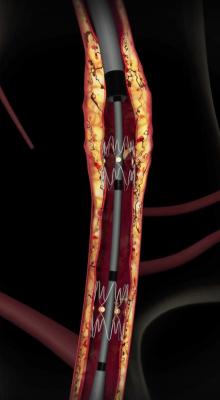
January 23, 2019 — A new report in the Journal of Vascular Surgery chronicles a multi-site randomized controlled trial comparing treatment efficacy, functional outcomes, cost effectiveness and quality of life for various treatments for critical limb ischemia (CLI). The trial will enroll 2,100 patients suffering from CLI, a debilitating and increasingly common manifestation of peripheral arterial disease (PAD) that puts patients at high risk for leg amputation, cardiovascular complications and death.
“The BEST-CLI Trial is Nearing the Finish Line and Promises to be Worth the Wait,”1 is authored by:
-
Alik Farber, M.D., chief of vascular and endovascular surgery at Boston Medical Center;
-
Michael Strong, the national trial manager, Brigham and Women's Hospital;
-
Kenneth Rosenfield, M.D., section head for vascular medicine and intervention at Massachusetts General Hospital;
-
Flora Sandra Siami, MPH, vice president, clinical, regulatory, quality at the New England Research Institutes; and
-
Matthew Menard, M.D., co-director of endovascular surgery at Brigham and Women's Hospital.
Farber, Rosenfield, Siami and Menard are principal investigators of the trial.
CLI, also known as chronic limb-threatening ischemia, is a condition in which there is insufficient blood flow to an extremity, such as an arm or leg, to allow for normal metabolic function. As the population ages and the incidence of diabetes, obesity and chronic kidney disease increases, so will the incidence of peripheral arterial disease and, consequently, CLI. A study published in 2011 found that insufficient management of CLI is responsible for substantial healthcare and societal costs – and these figures continue to increase nationally.2
Globally recognized vascular medicine specialist and President of Newton-Wellesley Hospital Michael R. Jaff, DO, considers the BEST-CLI Trial to be "...the most important, impactful, patient-centered clinical trial of critical limb ischemia of my professional lifetime."
Watch the VIDEO: State of Therapy for Critical Limb Ischemia, an interview with Jaff at ACC.16.
With 134 active enrollment sites and new sites being added, including sites in Europe and New Zealand, BEST-CLI has become an international effort. It has encountered a number of obstacles, but they are successfully being navigated.
“Perhaps the most difficult barrier we’ve encountered in getting patients enrolled in the study is that of treatment bias,” said Farber. “Despite widespread agreement that an evidence-based standard of care is lacking in patients with the condition, most physicians hold individual biases with regard to whether open or endovascular revascularization strategy is best for any given patient.”
To have the trial most accurately reflect contemporary practice, the results be accepted by the entire spectrum of CLI caregivers and to help overcome treatment bias, the lead investigators felt it was important to have everyone providing CLI care at participating trial sites involved. To achieve this, each participating site was encouraged to create “CLI teams.”
“A dedicated effort was undertaken to foster widespread multidisciplinary engagement and participation,” said Menard. “We believe that investigators working in CLI teams will facilitate optimal outcomes both for patients and for the trial.”
That posed a challenge for institutions with limited enthusiasm for cross-specialty collaboration, and in many cases, resulted in an entirely new model for decision-making and teamwork around CLI treatment. The study itself was designed with comprehensive input from expert trialists in the fields of vascular surgery, interventional radiology, interventional cardiology and vascular medicine, with the express goal of integrating the unique perspectives of each subspecialty. Sixty-six percent of investigators are vascular surgeons, 15 percent are interventional cardiologists and 14 percent are radiologists; 72 percent of the sites are multidisciplinary.
An additional enrollment obstacle is patients’ willingness to participate, which may be affected by both patient perceptions that endovascular options are less invasive than lower extremity bypass and provider bias.
The BEST-CLI principal investigators broadened eligibility criteria through a protocol amendment, which did not undermine the effect on pragmatic trial design. They also used social media, weekly coordinator calls, bi-monthly newsletters, articles in vascular periodicals, and presentations at national and international meetings to enhance recruitment efforts. The site outreach program has included more than 105 individual site visits and 45 webinars led by the national trial chairs. During meetings with CLI teams, the BEST-CLI protocol was reviewed, misconceptions were corrected, treatment bias was exposed and discussed through specific case presentations, and strategies to overcome such bias were highlighted.
“The BEST CLI trial is a versatile effort that aims to answer relevant, unresolved questions in the realm of peripheral arterial disease,” said Rosenfield. “We hope it will answer the principal question of how lower extremity bypass using a single segment of greater saphenous vein compares to endovascular therapy and will help providers treating patients with CLI clarify whether an endovascular-first approach is appropriate in patients who have a good autogenous vein.”
Funding for the BEST-CLI trial was provided by the National Heart, Lung, and Blood Institute, part of the National Institutes of Health.
For more information: www.jvascsurg.org
Related Content
New Technologies to Treat Peripheral Artery Disease (PAD)
References
1. Farber A., Rosenfield K., Siami F.S., et al. The BEST-CLI trial is nearing the finish line and promises to be worth the wait. Journal of Vascular Surgery, February 2019. https://doi.org/10.1016/j.jvs.2018.05.255
2. Sachs T., Pomposelli F., Hamdan A., et al. Trends in the national outcomes and costs for claudication and limb threatening ischemia: Angioplasty vs bypass graft. Journal of Vascular Surgery, October 2011. https://doi.org/10.1016/j.jvs.2011.03.281


 April 24, 2024
April 24, 2024 








